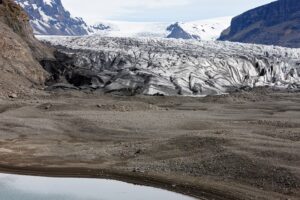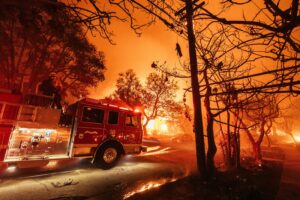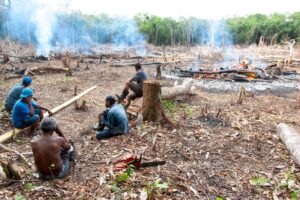Removing CO2 from the atmosphere using land-based mitigation strategies is central to nearly every country’s net-zero target.
To mitigate global climate change, land-use and land-management sectors need to reduce greenhouse gas emissions and remove carbon from the atmosphere.
Protecting ecosystems and dedicating more land to nature-based solutions and climate-smart agricultural practices are promising ways to do so.
To date, there has been little work looking at where, specifically, these strategies may be in conflict with one another.
Our research, published in Global Change Biology, assesses opportunity costs among 19 different land-use strategies for climate mitigation.
We find that roughly 8.5bn hectares of land around the globe are suitable for at least one land-based mitigation strategy – representing about 60% of the Earth’s land surface.
However, almost 40% of this land is suitable for more than one mitigation strategy, presenting decisionmakers with a choice as to which strategy or strategies they should deploy.
Land-based mitigation
To achieve global climate targets in a timely manner, some studies call for up to 10% of Earth’s terrestrial surface to undergo a land-cover change.
But is there actually enough land to make this happen? And if there is, how can projects be scaled up strategically to maximise the mitigation benefits while minimising negative impacts on humans and biodiversity?
Disciplinary silos and practical uncertainties have previously made these questions hard to answer.
For instance, nature-based solutions, including habitat conservation and restoration, are often differentiated from other climate-motivated land-use practices, such as bioenergy cropping and afforestation. Yet, both types of practices can have significant trade-offs for biodiversity and for agriculture.
Although controversial, these types of climate-specific land-use changes are proposed in many national climate mitigation plans. As these plans are put in motion, the trade-offs that could result from increasing the land dedicated to certain strategies over others need careful consideration.
In our study, we assess land-use opportunity costs across a portfolio of 19 different strategies for climate mitigation.
Broadly speaking, these strategies can be classified into four main approaches to mitigation: maintaining or protecting ecosystems, modifying forestry or agricultural management practices, restoring ecosystems and converting land to increase biomass.
Of these, certain approaches and strategies can be used to avoid emissions, while others can be used to sequester carbon.
Among the strategies we studied are the protection and restoration of forest, wetland, peatland and grassland habitats, various approaches to climate-smart cropland and forestry management (including biochar and silvopasture), bioenergy cropping with carbon capture and storage and afforestation.
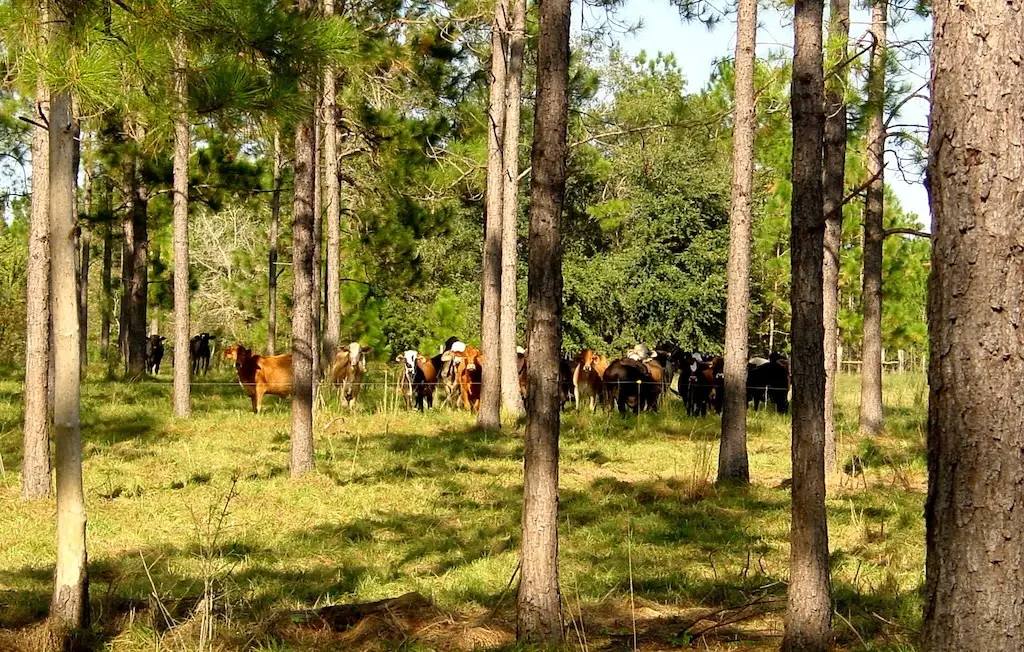
We used global datasets on forests, croplands and other habitat types alongside data on environmental conditions such as temperature to estimate how much of the global land area is suitable for each strategy.
Then, we created global maps at a one kilometre resolution that identify areas that could be considered for these measures.
Land potentials
We find that some strategies had large regions of suitability.
For example, deforestation and other types of habitat loss are a large contributor to greenhouse gas emissions from the land-use sector. Maintaining grassland and forest habitat types to prevent losses can be done anywhere that such loss is occurring.
Maintaining the carbon stored in ecosystems that are currently unprotected accounts for more than 3bn hectares of the land we estimate as suitable for land-based climate mitigation – equal to about 20% of the Earth’s land surface.
Other strategies, including peatland restoration and silvopasture, had much more restricted areas of suitability across the globe.
For peatland restoration, priority areas are primarily distributed in the boreal zone – the high-latitude northern hemisphere, just south of the Arctic. Cropland expansion has led to widespread peatland loss in this region over the past several decades.
For silvopasture – a type of livestock farming that integrates tree cover with grazing – suitability is primarily constrained by environmental limits on tree growth. Here, factors such as water availability determine in which regions traditional pastoral systems could be converted to silvopasture.
The figure below shows the 19 mitigation strategies we studied and the area of the Earth that is suitable for each, in millions of hectares. The three maps on the right show example distributions for (from top to bottom) enhanced chemical weathering, bioenergy with carbon capture and storage (BECCS) and integrating trees into croplands.

Conflict potential
When summing the suitable area across all the 19 strategies we examined, we find that a huge area of Earth – almost 60% of its land surface – is theoretically suitable for land-based climate mitigation.
However, the majority of this area captures regions where more than one mitigation strategy is suitable.
In some cases, these overlapping land potentials involve mitigation strategies that can be deployed jointly, such as increasing the carbon stored in soils at the same time as increasing the carbon stored in aboveground biomass.
One example of this is the potential to collectively implement enhanced chemical weathering and improved plantation management, which have a combined land suitability of 348m hectares.
(Enhanced chemical weathering involves spreading ground-up silicate rocks onto farms or other land. This speeds up natural chemical processes and removes CO2 from the atmosphere, while also improving crop yields.)
However, suitable areas for compatible strategies were rare, compared to the area where conflicts between strategies could occur.
For instance, large portions of the US, Europe and China are suitable for both ecosystem restoration and climate-smart agriculture.
In these regions, societies face a choice between restoring grassland, forest and wetland habitats, or continuing to manage the land for agriculture, where climate-smart practices could still be implemented to decrease greenhouse gas emissions or sequester more carbon.
Because the choice between large-scale restoration and climate-smart agriculture may involve a trade-off between restoring habitat for biodiversity or maintaining land use for people, we avoid making any recommendations about which land-use practices to implement.
Rather, our paper highlights areas where these trade-offs could occur – places in which large-scale top-down planning could conflict with local priorities for land-use.
More research is needed to map local constraints and management costs so that the choice between mitigation strategies aligns local needs with national and global targets for climate mitigation.
Opportunity costs
So, with these potential overlaps and conflicts, is there enough land to meet climate targets?
The answer is yes, in theory – the summed area we estimate as suitable for climate mitigation is more than double the amount of land that has been pledged for transformation by UN member countries in their pledges to meet the goals of the Paris Agreement.
However, the pace of on-the-ground implementation lags far behind the degree of land-use change needed to limit warming by 2050. And high-level constraints, such as meagre financing or a lack of political incentives, will continue to stall progress.
Given these choices and constraints, land-use opportunity costs should be considered when planning policies that may incentivise certain types of mitigation practices that could inadvertently displace opportunities for others.
As plans to reach net-zero continue to develop, the atlas of maps for mitigation practices – and the exploration of opportunity costs – can guide pathways for scaling up land-based mitigation to address climate change.
The post Guest post: The conflicting practices in using land to tackle climate change appeared first on Carbon Brief.
Guest post: The conflicting practices in using land to tackle climate change
Climate Change
UN report: Five charts showing how global deforestation is declining
The amount of forest lost around the world has reduced by millions of hectares each year in recent decades, but countries are still off track to meet “important” deforestation targets.
These are the findings of the Global Forest Resources Assessment – a major new report from the UN’s Food and Agriculture Organization – which says that an estimated 10.9m hectares (Mha) of land was deforested each year between 2015 and 2025.
This is almost 7Mha less than the amount of annual forest loss over 1990-2000.
Since 1990, the area of forest destroyed each year has halved in South America, although it still remains the region with the highest amount of deforestation.
Europe was the only region in the world where annual forest loss has increased since 1990.
Agriculture has historically been the leading cause of deforestation around the world, but the report notes that wildfires, climate change-fuelled extreme weather, insects and diseases increasingly pose a threat.
The Global Forest Resources Assessment is published every five years. The 2025 report compiles and analyses national forest data from almost every country in the world over 1990-2025.
Carbon Brief has picked out five key findings from the report around deforestation, carbon storage and the amount of forest held within protected areas around the world.
1. Rates of deforestation are declining around the world
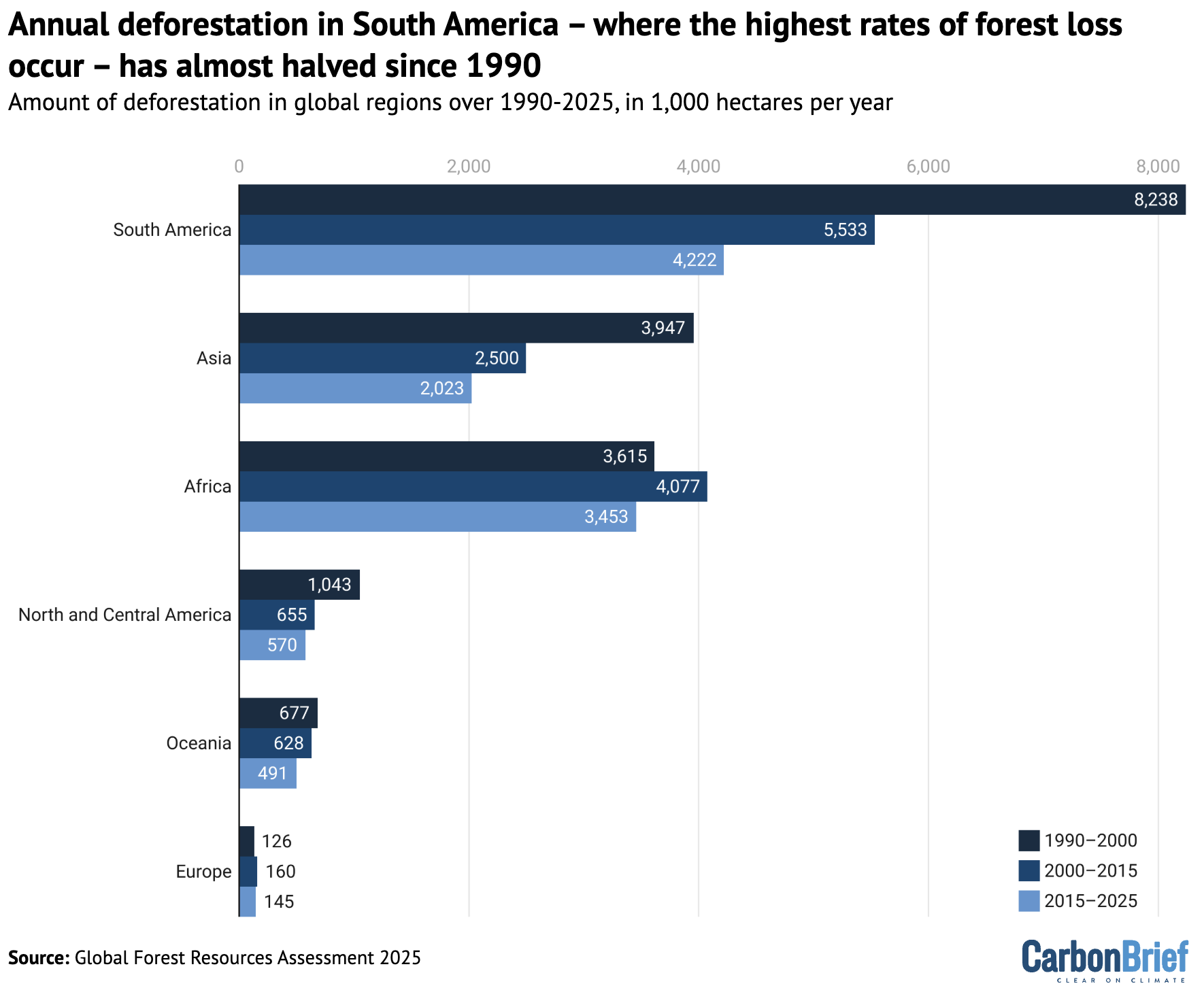
Rates of annual deforestation, in thousands of hectares, in South America, Asia, Africa, North and Central America, Oceania and Europe over 1990-2000 (dark blue), 2000-15 (medium blue) and 2015-25 (light blue). Source: Global Forest Resources Assessment 2025
In total, around 489Mha of forest have been lost due to deforestation since 1990, the new report finds. Most of this – 88% – occurred in the tropics.
This breaks down to around 10.9Mha of forest lost each year between 2015 and 2025, a reduction compared to 13.6Mha of loss over 2000-15 and 17.6Mha over 1990-2000.
Deforestation refers to the clearing of a forest, typically to repurpose the land for agriculture or use the trees for wood.
The chart above shows that South America experiences the most forest loss each year, although annual deforestation levels have halved from 8.2Mha over 1990-2000 to 4.2Mha over 2015-25.
Annual deforestation in Asia also saw a sizable reduction, from 3.9Mha over 1990-2000 to 2Mha over 2015-25, the report says.
Europe had the lowest overall deforestation rates, but was also the only region to record an increase over the last 35 years, with deforestation rates growing from 126,000 hectares over 1990-2000 to 145,000 hectares in the past 10 years.
Despite the downward global trend, FAO chief Dr Qu Dongyu notes in the report’s foreword that the “world is not on track to meet important global forest targets”.
In 2021, more than 100 countries pledged to halt and reverse global deforestation by 2030. But deforestation rates in 2024 were 63% higher than the trajectory needed to meet this 2030 target, according to a recent report from civil society groups.
The goals of this pledge were formally recognised in a key text at the COP28 climate summit in Dubai in 2023, which “emphasise[d]” that halting and reversing deforestation and forest degradation by 2030 would be key to meeting climate goals.
2. Global net forest loss has more than halved since 1990
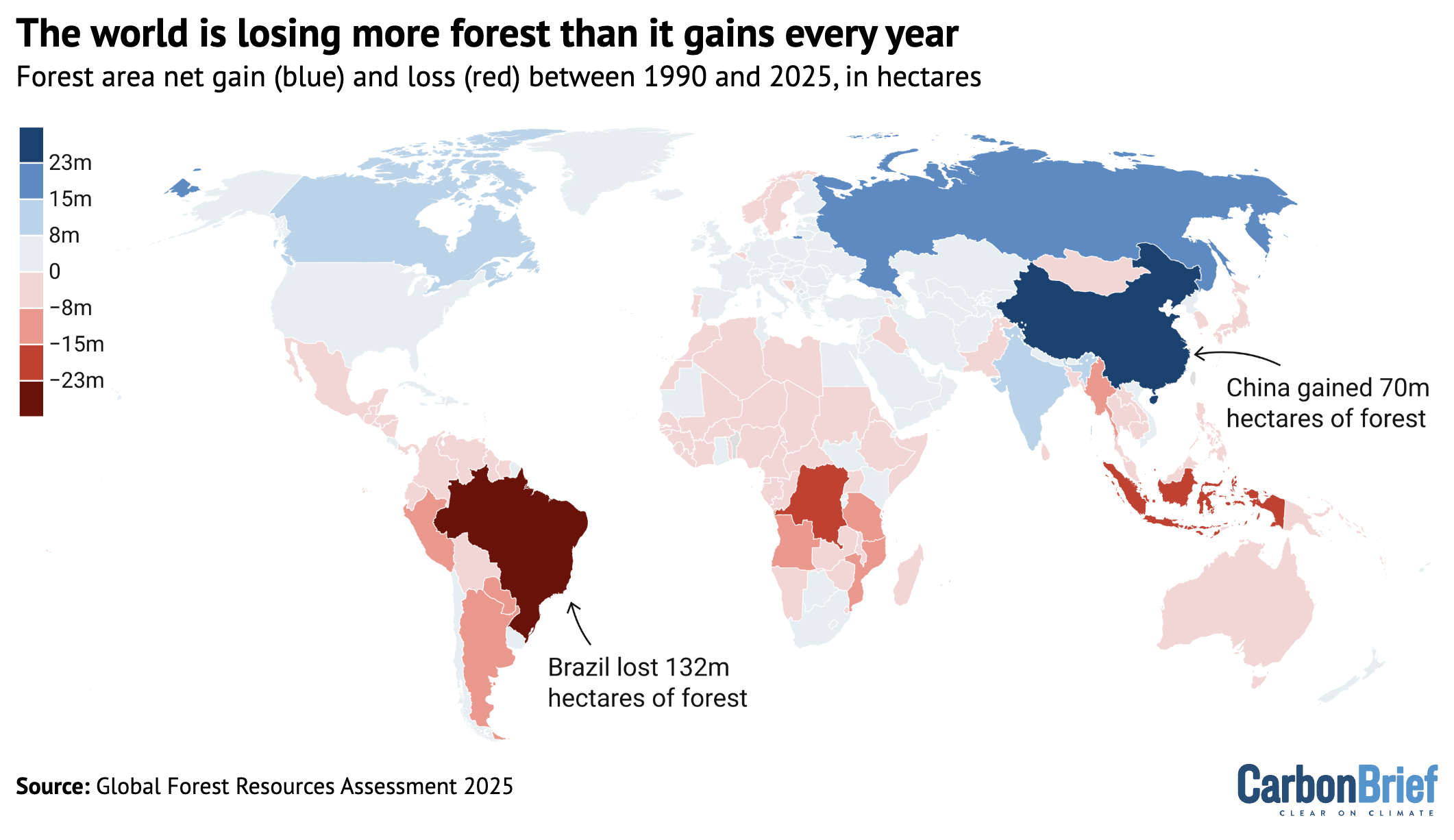
Forest area net change by country between 1990 and 2025, in hectares. Source: Global Forest Resources Assessment 2025
The new report finds that forests cover more than 4bn hectares of land, an area encompassing one-third of the planet’s land surface.
More than half of the world’s forested area is located in just five countries: Russia, Brazil, Canada, the US and China.
The map above shows that, overall, more forest is lost than gained each year around the world. There was 6.8Mha of forest growth over 2015-25, but 10.9Mha of forest lost.
The annual rate of this global net forest loss – the amount that deforestation has exceeded the amount regrown – has more than halved since 1990, dropping from 10.7Mha over 1990-2000 to 4.1Mha over 2015-25.
The report says this change was due to reduced deforestation in some countries and increased forest expansion in others. However, the rate of forest expansion has also slowed over time – from 9.9Mha per year in 2000-15 to 6.8Mha per year in 2015-25.
There are many driving factors behind continuing deforestation. Agriculture has historically been the leading cause of forest loss, but wildfire is increasingly posing a threat. Wildfires were the leading driver of tropical forest loss in 2024 for the first time on record, a Global Forest Watch report found earlier this year.
The new UN report says that an average of 261Mha of land was burned by fire each year over 2007-19. Around half of this area was forest. Around 80% of the forested land impacted by fires in 2019 was in the subtropics – areas located just outside tropical regions, such as parts of Argentina, the US and Australia.
The report notes that fire is widely used in land management practices, but uncontrolled fires can have “major negative impacts on people, ecosystems and climate”.
It adds that researchers gathered information on fires up as far as 2023, but chose to focus on 2007-19 due to a lack of more recent data for some countries.
A different report from an international team of scientists recently found that fires burned at least 370Mha of land – an area larger than India – between March 2024 and February 2025.
3. Many countries are hugely increasing their forest area
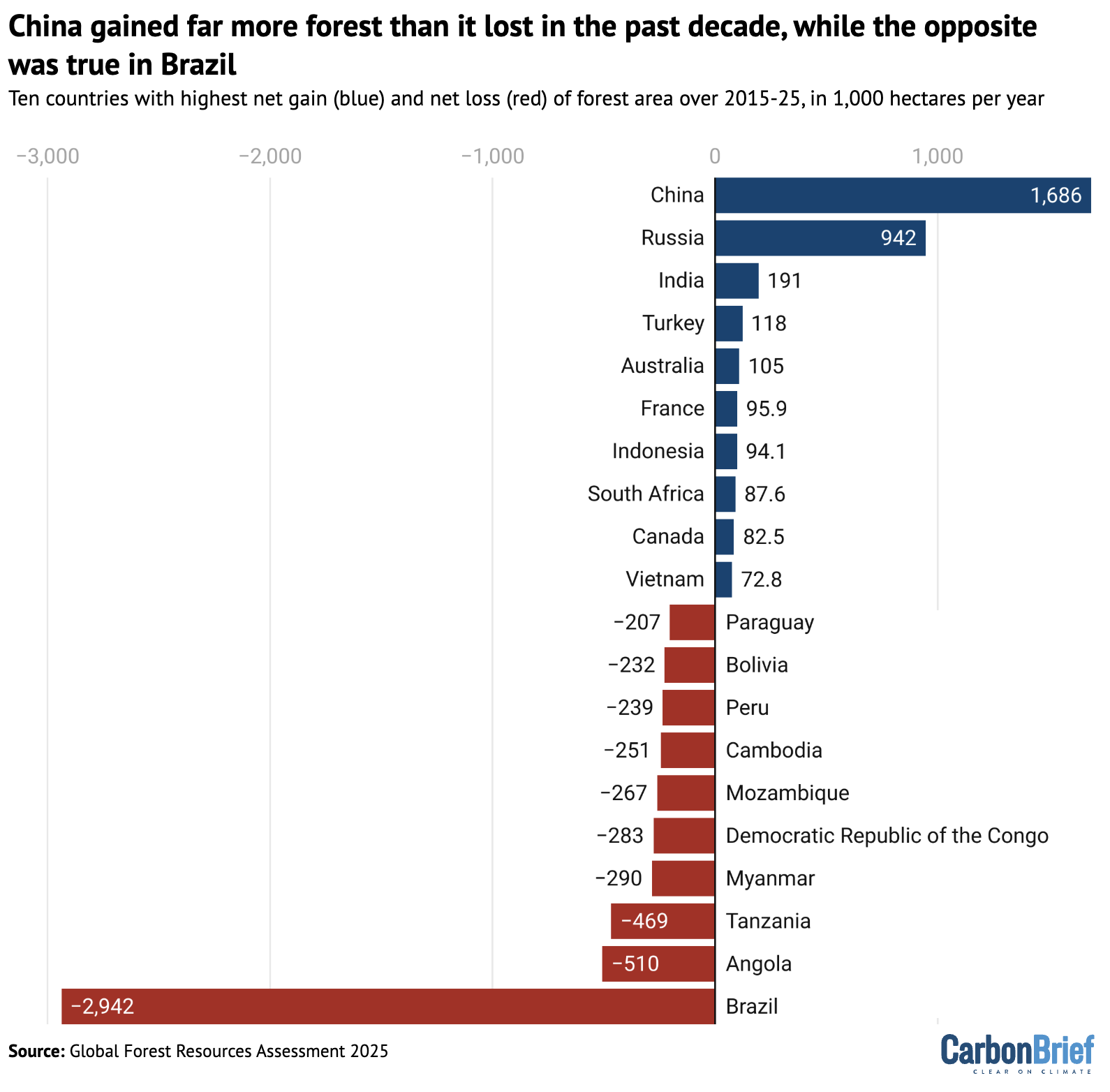
Top 10 countries for annual net gain (blue) and net loss (red) of forest area over 2015-25, in 1,000 hectares per year. Source: Global Forest Resources Assessment 2025
Globally, deforestation is declining, but the trend varies from country to country.
The chart above shows that some nations, such as China and Russia, added a lot more forest cover than they removed in the past decade through, for example, afforestation programmes.
But in other countries – particularly Brazil – the level of deforestation far surpasses the amount of forest re-grown.
Deforestation in Brazil dropped by almost one-third between 2023 and 2024, news outlet Brasil de Fato reported earlier this year, which was during the time Luiz Inácio Lula da Silva took over as president. The new UN report finds that, on average, Brazil lost 2.9Mha of forest area each year over 2015-25, compared to 5.8Mha over 1990-2000.
Russia’s net gain of forest cover increased significantly since 1990 – growing from 80,400ha per year in 1990-2000 to 942,000ha per year in 2015-25.
In China, although it is also planting significant levels of forest, the forest level gained has dropped over time, from 2.2Mha per year in 2000-15 to 1.7Mha per year in 2015-25.
Levels of net forest gain in Canada also fell from 513,000ha per year in 2000-15 to 82,500ha per year in 2015-25.
In the US, the net forest growth trend reversed over the past decade – from 437,000ha per year of gain in 2000-15 to a net forest loss of 120,000ha per year from 2015 to 2025.
Oceania reversed a previously negative trend to gain 140,000ha of forests per year in the past decade, the report says. This was mainly due to changes in Australia, where previous losses of tens of thousands of hectares each year turned into an annual net gain of 105,000ha each year by 2015-25.
4. The world’s forests hold more than 700bn tonnes of carbon
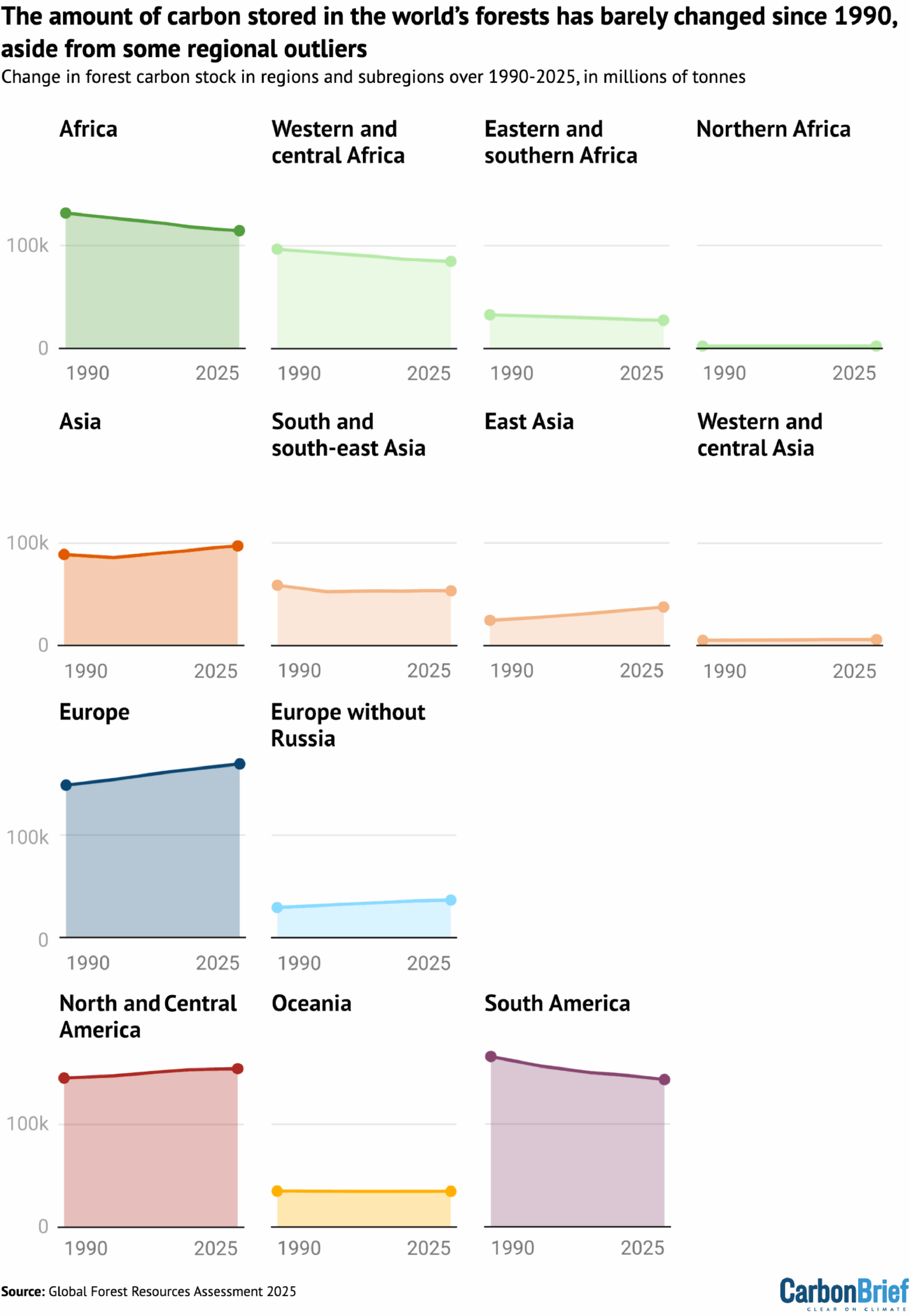
Changes in forest carbon stock by region and subregion of the world over 1990-2025. Source: Global Forest Resources Assessment 2025
The “carbon stock” of a forest refers to how much carbon is stored in its trees and soils. Forests are among the planet’s major carbon sinks.
The new report estimates that forests stored an estimated 714bn tonnes, or gigatonnes, of carbon (GtC) in 2025.
Europe (including Russia) and the Americas account for two-thirds of the world’s total forest carbon storage.
The global forest carbon stock decreased from 716GtC to 706GtC between 1990 and 2000, before growing slightly again by 2025. The report mainly attributes this recent increase to forest growth in Asia and Europe.
The report notes that the total amount of carbon stored in forests has remained largely static over the past 35 years, but with some regional differences, as highlighted in the chart above.
The amount of carbon stored in forests across east Asia, Europe and North America is “significantly higher” now due to expanded forest areas, but it is lower in South America, Africa and Central America.
Several studies have shown that there are limitations on the ability of forests to keep absorbing CO2, with difficulties posed by hotter, drier weather fuelled by climate change.
A 2024 study found that record heat in 2023 negatively impacted the ability of land and ocean sinks to absorb carbon – and that the global land sink was at its weakest since 2003.
Another study, published in 2022, said that drying and warming as a result of deforestation reduces the carbon storage ability of tropical forests, especially in the Congo basin and the Amazon rainforest.
5. Around one-fifth of the world’s forests are located in protected areas
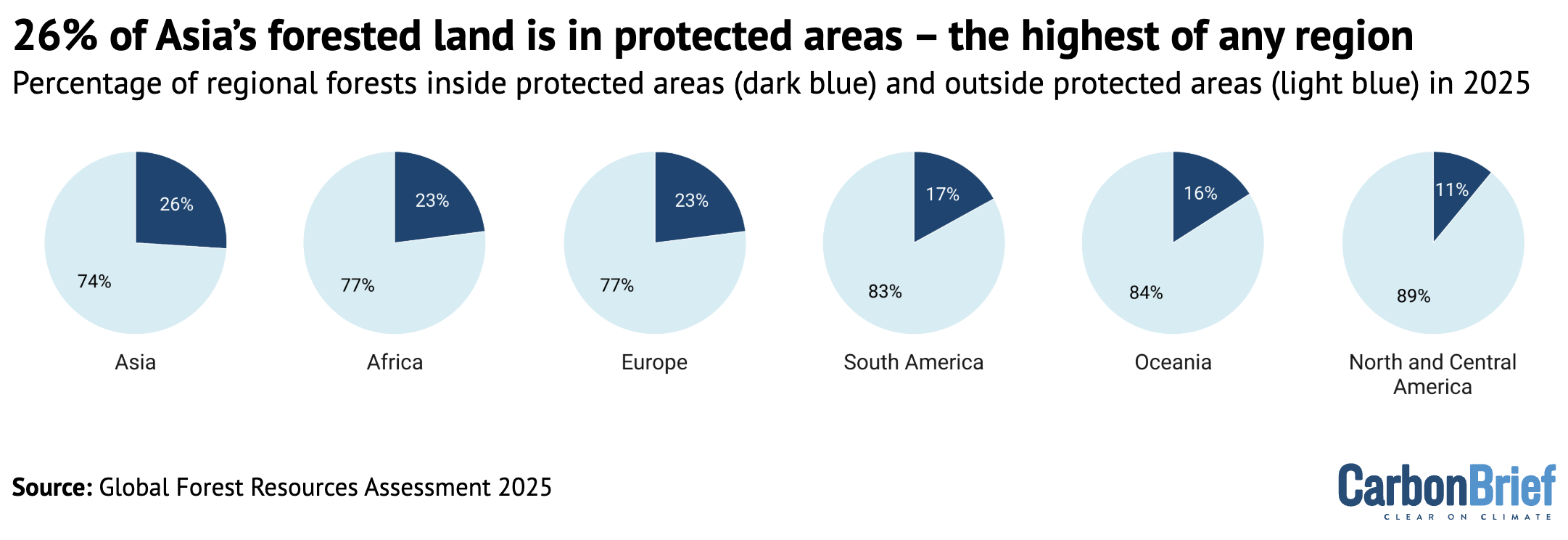
The percentage of forest land in Asia, Africa, Europe, South America, Oceania and North and Central America contained inside protected areas (dark blue) and outside protected areas (light blue) in 2025. Source: Global Forest Resources Assessment 2025
The amount of forested land located in protected areas increased across all regions between 1990 and 2025.
For an area to be considered “protected”, it must be managed in a way that conserves nature.
Around 20% of the world’s forests are located in these protected areas, the new report finds, which amounts to 813Mha of land – an area almost the size of Brazil.
Nearly every country in the world has pledged to protect 30% of the Earth’s land and sea by 2030. However, more than half of countries have not committed to this target on a national basis, Carbon Brief analysis showed earlier this year.
Almost 18% of land and around 8% of the ocean are currently in protected areas, a UN report found last year. The level is increasing, the report said, but considerable progress is still needed to reach the 2030 goal.
The new UN report notes that Europe, including Russia, holds 235Mha of protected forest area, which is the largest of any region and accounts for 23% of the continent’s total forested land.
As highlighted in the chart above, 26% of all forests in Asia are protected, which is the highest of any region. The report notes that this is largely due to a vast amount of protected forested land in Indonesia.
Three countries and one island territory reported that upwards of 90% of their forests are protected – Norfolk Island, Saudi Arabia, Cook Islands and Uzbekistan.
The post UN report: Five charts showing how global deforestation is declining appeared first on Carbon Brief.
UN report: Five charts showing how global deforestation is declining
Climate Change
Federal Appeals Court Pauses Litigation Over Florida’s Alligator Alcatraz
The Trump administration had sought the stay of proceedings in the case, arguing its attorneys were furloughed during the government shutdown. The plaintiffs say the administration is picking and choosing which cases to litigate.
A federal appeals court paused litigation Wednesday brought by environmental groups over Florida’s Alligator Alcatraz, the hastily assembled Everglades detention site where the Trump administration aims to incarcerate and deport thousands of undocumented migrants.
Federal Appeals Court Pauses Litigation Over Florida’s Alligator Alcatraz
Climate Change
Breach of Contract or Constitutional Crisis?
An appellate court will determine how to handle the Trump administration’s cancellation of hundreds of climate and environmental justice grants.
The U.S. Fourth Circuit Court of Appeals in Richmond, Virginia, heard arguments Thursday on whether the Trump administration’s cancellation of billions of dollars in environmental and climate grants earlier this year violated the Constitution or was merely a contract dispute.
-
Climate Change2 years ago
Spanish-language misinformation on renewable energy spreads online, report shows
-
Climate Change2 months ago
Guest post: Why China is still building new coal – and when it might stop
-
Climate Change Videos2 years ago
The toxic gas flares fuelling Nigeria’s climate change – BBC News
-

 Greenhouse Gases1 year ago
Greenhouse Gases1 year ago嘉宾来稿:满足中国增长的用电需求 光伏加储能“比新建煤电更实惠”
-
Greenhouse Gases2 months ago
Guest post: Why China is still building new coal – and when it might stop
-

 Climate Change1 year ago
Climate Change1 year ago嘉宾来稿:满足中国增长的用电需求 光伏加储能“比新建煤电更实惠”
-

 Carbon Footprint2 years ago
Carbon Footprint2 years agoUS SEC’s Climate Disclosure Rules Spur Renewed Interest in Carbon Credits
-
Renewable Energy3 months ago
US Grid Strain, Possible Allete Sale


